Using Machine Learning Classifiers to Recognize the Mixture Control Chart Patterns for a Multiple-Input Multiple-Output Process
Abstract
1. Introduction
2. MIMO and Disturbance Models
2.1. MIMO Models
2.2. Disturbance Models
3. Methodology and Experimental Results
3.1. ELM Classifier
3.2. MCCPs for an MIMO Process
3.3. Research Framework
3.4. Four Cases and the Recognition Results
4. Discussion
5. Conclusions
Author Contributions
Funding
Acknowledgments
Conflicts of Interest
References
- Shewhart, W.A. Economic Control of Quality of Manufactured Product; D. Van Nostrand Company, Inc.: New York, NY, USA, 1931. [Google Scholar]
- Western Electric Company. Statistical Quality Control Handbook; Western Electric Company: New York, NY, USA, 1956. [Google Scholar]
- Lu, C.J.; Shao, Y.E.; Li, P.H. Mixture control chart patterns recognition using independent component analysis and support vector machine. Neurocomputing 2011, 74, 1914–2011. [Google Scholar] [CrossRef]
- De la Torre Gutiérrez, H.; Pham, D.T. Identification of patterns in control charts for processes with statistically correlated noise. Int. J. Prod. Res. 2018, 56, 1504–1520. [Google Scholar] [CrossRef]
- Gutierrez, H.D.; Pham, D.T. Estimation and generation of training patterns for control chart pattern recognition. Comput. Ind. Eng. 2016, 95, 82–2016. [Google Scholar]
- Xanthopoulos, P.; Razzaghi, T. A weighted support vector machine method for control chart pattern recognition. Comput. Ind. Eng. 2014, 70, 134–149. [Google Scholar] [CrossRef]
- El-Midany, T.T.; El-Baz, M.A.; Abd-Elwahed, M.S. A proposed framework for control chart pattern recognition in multivariate process using artificial neural networks. Expert Syst. Appl. 2010, 37, 1035–1042. [Google Scholar] [CrossRef]
- Ghomi, S.F.; Lesany, S.A.; Koochakzadeh, A. Recognition of unnatural patterns in process control charts through combining two types of neural networks. Appl. Soft Comput. 2011, 11, 5444–5456. [Google Scholar] [CrossRef]
- Gauri, S.; Chakraborty, S. Improved recognition of control chart patterns using artificial neural networks. Int. J. Adv. Manuf. Technol. 2008, 36, 1191–1201. [Google Scholar] [CrossRef]
- Ebrahimzadeh, A.; Addeh, J.; Rahmani, Z. Control chart pattern recognition using K-MICA clustering and neural networks. ISA Trans. 2012, 51, 111–119. [Google Scholar] [CrossRef]
- Addeh, A.; Khormali, A.; Golilarz, N.A. Control chart pattern recognition using RBF neural network with new training algorithm and practical features. ISA Trans. 2018, 79, 202–216. [Google Scholar] [CrossRef]
- Ebrahimzadeh, A.; Ranaee, V. Control chart pattern recognition using an optimized neural network and efficient features. ISA Trans. 2010, 49, 387–393. [Google Scholar] [CrossRef]
- Zhou, X.; Jiang, P.; Wang, X. Recognition of control chart patterns using fuzzy SVM with a hybrid kernel function. J. Intell. Manuf. 2015, 29, 51–67. [Google Scholar] [CrossRef]
- Lin, S.Y.; Guh, R.S.; Shiue, Y.R. Effective recognition of control chart patterns in autocorrelated data using a support vector machine based approach. Comput. Ind. Eng. 2011, 61, 1123–1134. [Google Scholar] [CrossRef]
- Du, S.; Huang, D.; Lv, J. Recognition of concurrent control chart patterns using wavelet transform decomposition and multiclass support vector machines. Comput. Ind. Eng. 2013, 66, 683–695. [Google Scholar] [CrossRef]
- Khormali, A.; Addeh, J. A novel approach for recognition of control chart patterns: Type-2 fuzzy clustering optimized support vector machine. ISA Trans. 2016, 63, 256–264. [Google Scholar] [CrossRef]
- Yang, W.A.; Zhou, W.; Liao, W.; Guo, Y. Identification and quantification of concurrent control chart patterns using extreme-point symmetric mode decomposition and extreme learning machines. Neurocomputing 2015, 147, 260–270. [Google Scholar] [CrossRef]
- Shao, Y.E.; Chiu, C.C. Applying emerging soft computing approaches to control chart pattern recognition for an SPC–EPC process. Neurocomputing 2016, 201, 28–2016. [Google Scholar] [CrossRef]
- Shao, Y.E.; Chang, P.Y.; Lu, C.J. Applying two-stage neural network based classifiers to the identification of mixture control chart patterns for an SPC-EPC process. Complexity 2017, 2017, 10. [Google Scholar] [CrossRef]
- Shao, Y.E.; Lin, S.C. Using a time delay neural network approach to diagnose the out-of-control signals for a multivariate normal process with variance shifts. Mathematics 2019, 7, 959. [Google Scholar] [CrossRef]
- Alshraideh, H.; Khatatbeh, E. A gaussian process control chart for monitoring autocorrelated process data. J. Qual. Technol. 2014, 46, 317–322. [Google Scholar] [CrossRef]
- Qiu, P.; Li, W.; Li, J. A new process control chart for monitoring short-range serially correlated data. Technometrics 2019. [Google Scholar] [CrossRef]
- Kadri, F.; Harrou, F.; Chaabane, S.; Sun, Y.; Tahon, C. Seasonal ARMA-based SPC charts for anomaly detection: Application to emergency department systems. Neurocomputing 2016, 173, 2102–2114. [Google Scholar] [CrossRef]
- He, Q.P.; Wang, J. Statistical process monitoring as a big data analytics tool for smart manufacturing. J. Process Control 2017, 67, 35–43. [Google Scholar] [CrossRef]
- Capaci, F.; Vanhatalo, E.; Kulahci, M.; Bergquist, B. The revised Tennessee Eastman process simulator as testbed for SPC and DoE methods. Qual. Eng. 2019, 31, 212–229. [Google Scholar] [CrossRef]
- John, B.; Singhal, S. An application of integrated EPC–SPC methodology for simultaneously monitoring multiple output characteristics. Int. J. Qual. Reliab. Manag. 2019, 36, 669–685. [Google Scholar] [CrossRef]
- Diao, G.; Zhao, L.; Yao, Y. A dynamic quality control approach by improving dominant factors based on improved principal component analysis. Int. J. Prod. Res. 2015, 53, 4287–4303. [Google Scholar] [CrossRef]
- Yang, W.A.; Zhou, W. Autoregressive coefficient-invariant control chart pattern recognition in autocorrelated manufacturing processes using neural network ensemble. J. Intell. Manuf. 2015, 26, 1180–2015. [Google Scholar] [CrossRef]
- Luo, M.; Zhang, K. A hybrid approach combining extreme learning machine and sparse representation for image classification. Eng. Appl. Artif. Intell. 2014, 27, 228–235. [Google Scholar] [CrossRef]
- Cao, J.; Hao, J.; Lai, X.; Vong, C.M.; Luo, M. Ensemble extreme learning machine and sparse representation classification. J. Frankl. Inst. 2016, 353, 4526–4541. [Google Scholar] [CrossRef]
- Shao, Y.E.; Hou, C.-D.; Chiu, C.-C. Hybrid intelligent modeling schemes for heart disease classification. Appl. Soft Comput. 2014, 14, 52–2014. [Google Scholar] [CrossRef]
- Shao, Y.E.; Hou, C.-D. Change point determination for a multivariate process using a two-stage hybrid scheme. Appl. Soft Comput. 2013, 13, 1527–2013. [Google Scholar] [CrossRef]
- Tseng, T.S.; Chou, J.R.; Lee, P.S. A study on a multivariate EWMA controller. IIE Trans. 2002, 34, 541–549. [Google Scholar] [CrossRef]
- Tseng, S.T.; Mi, H.C.; Lee, I.C. A multivariate EWMA controller for linear dynamic processes. Technometrics 2016, 58, 104–115. [Google Scholar] [CrossRef]
- Yang, L.; Sheu, S.H. Economic design of the integrated multivariate EPC and multivariate SPC charts. Qual. Reliab. Eng. Int. 2007, 23, 218–2007. [Google Scholar] [CrossRef]
- Gauri, S.K.; Chakraborty, S. Feature-based recognition of control chart patterns. Comput. Ind. Eng. 2006, 51, 726–742. [Google Scholar] [CrossRef]
- Vapnik, V.N. The Nature of Statistical Learning Theory; Springer: Berlin/Heidelberg, Germany, 2000. [Google Scholar]
- Cherkassky, V.; Ma, Y. Practical selection of SVM parameters and noise estimation for SVM regression. Neural Netw. 2004, 17, 126–2004. [Google Scholar] [CrossRef]
- Friedman, J.H. Multivariate adaptive regression splines (with discussion). Ann. Stat. 1991, 19, 141–1991. [Google Scholar]
- Huang, G.B.; Zhu, Q.Y.; Siew, C.K. Extreme learning machine: Theory and applications. Neurocomputing 2006, 70, 501–2006. [Google Scholar] [CrossRef]
- RStudio. Available online: https://rstudio.com/products/rstudio/ (accessed on 23 May 2017).
- Hsu, C.W.; Chang, C.C.; Lin, C.J. A Practical Guide to Support Vector Classification; Technical Report; Department of Computer Science and Information Engineering, National Taiwan University: Taipei, Taiwan, 2003. [Google Scholar]
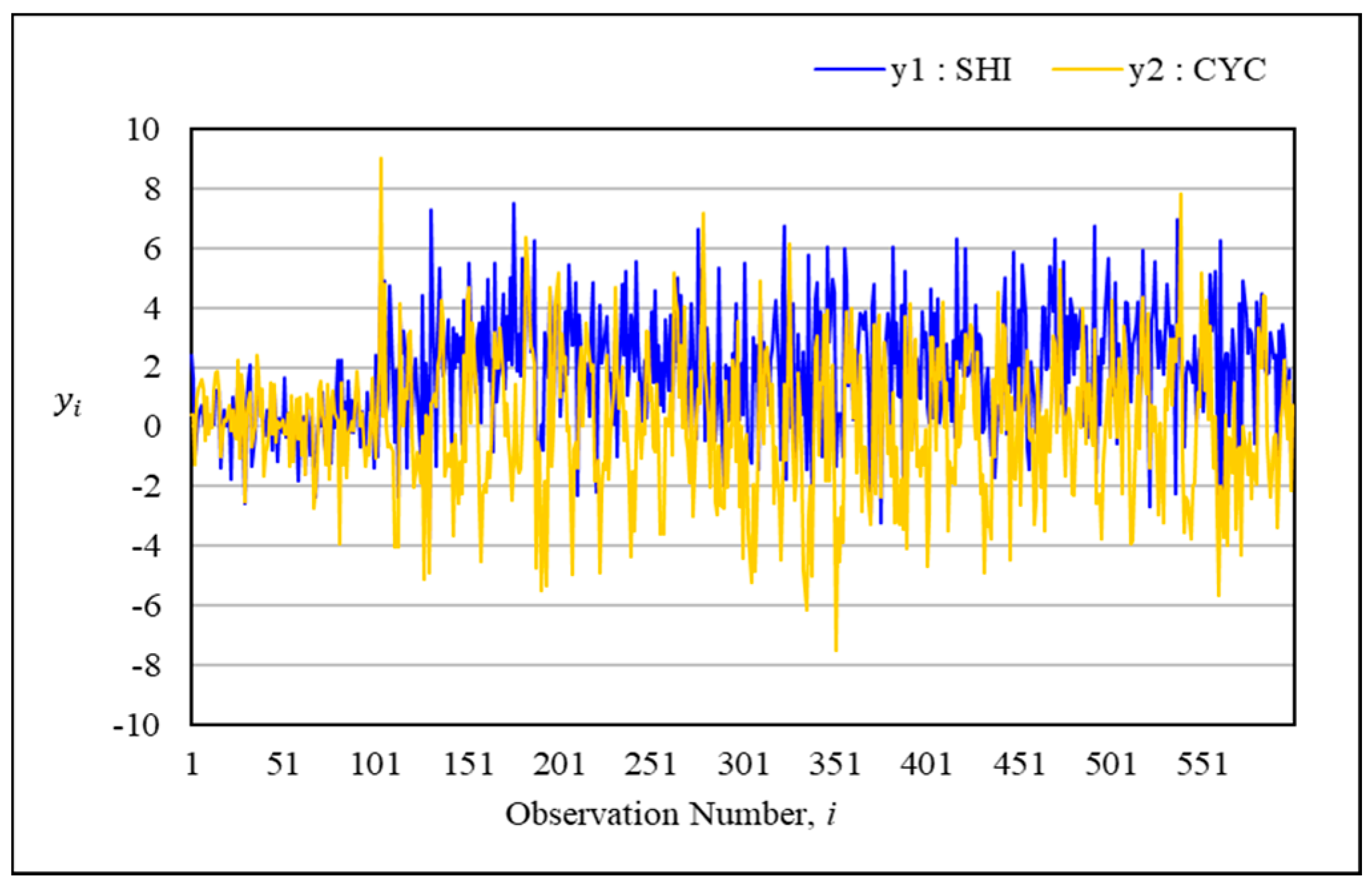
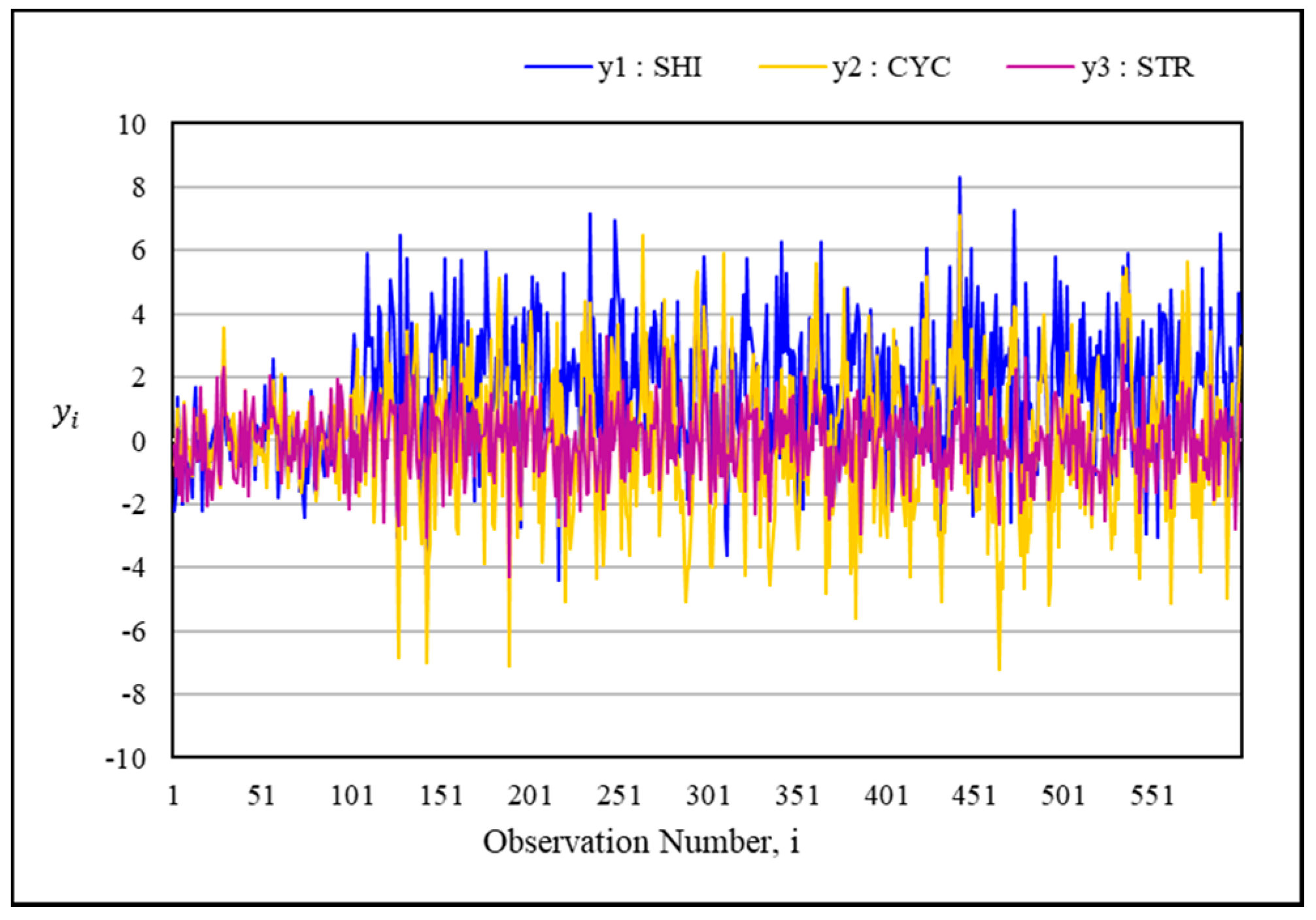
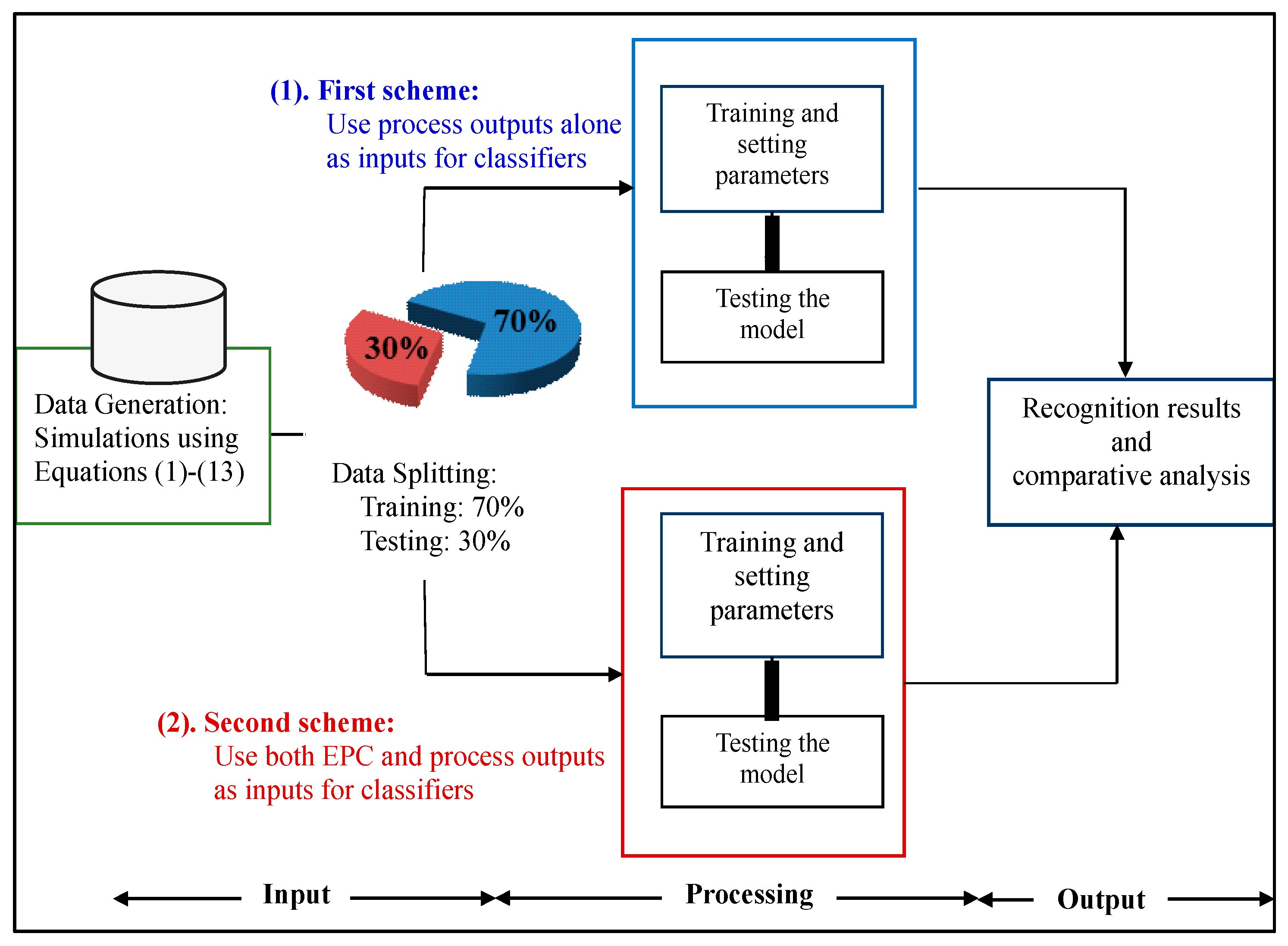
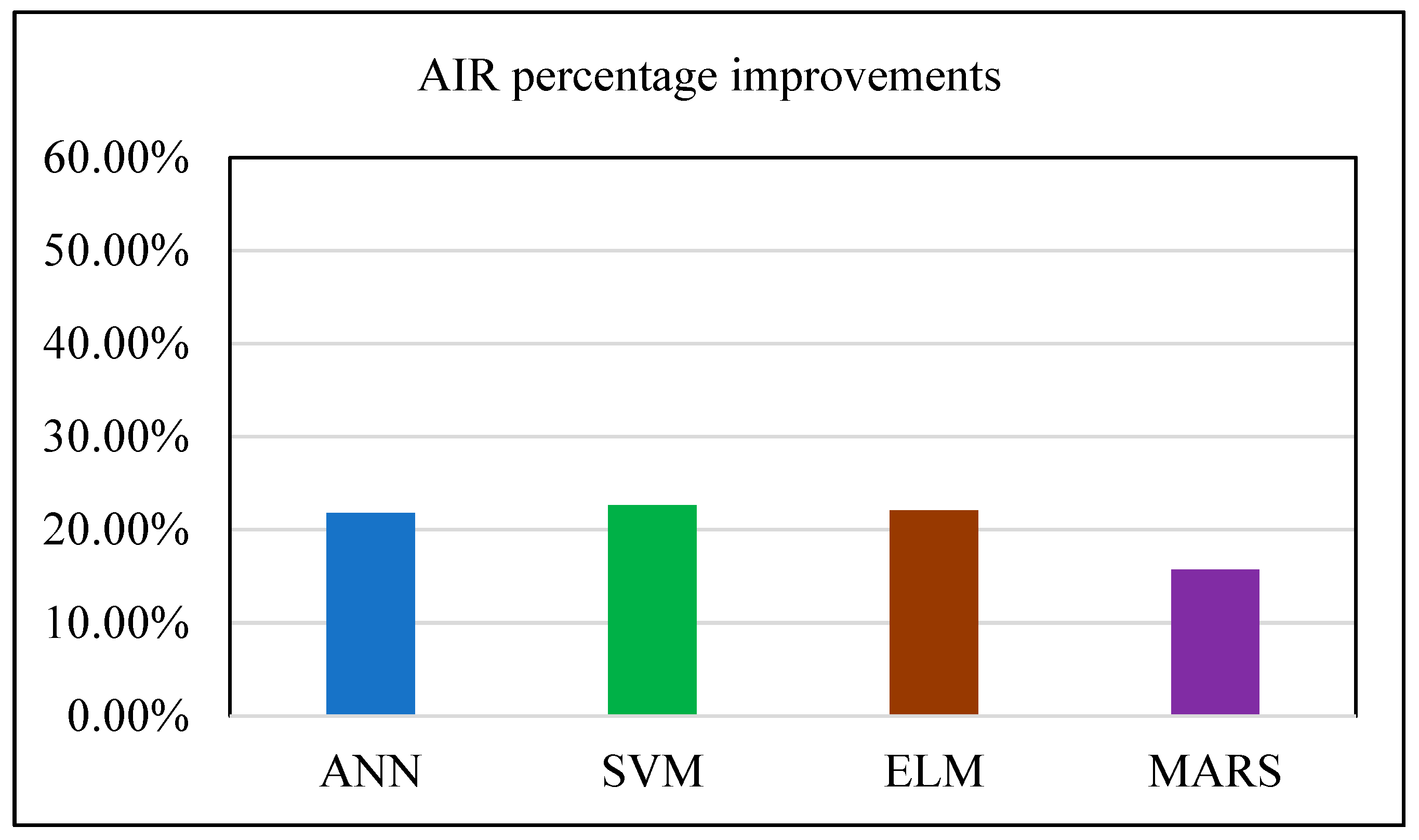
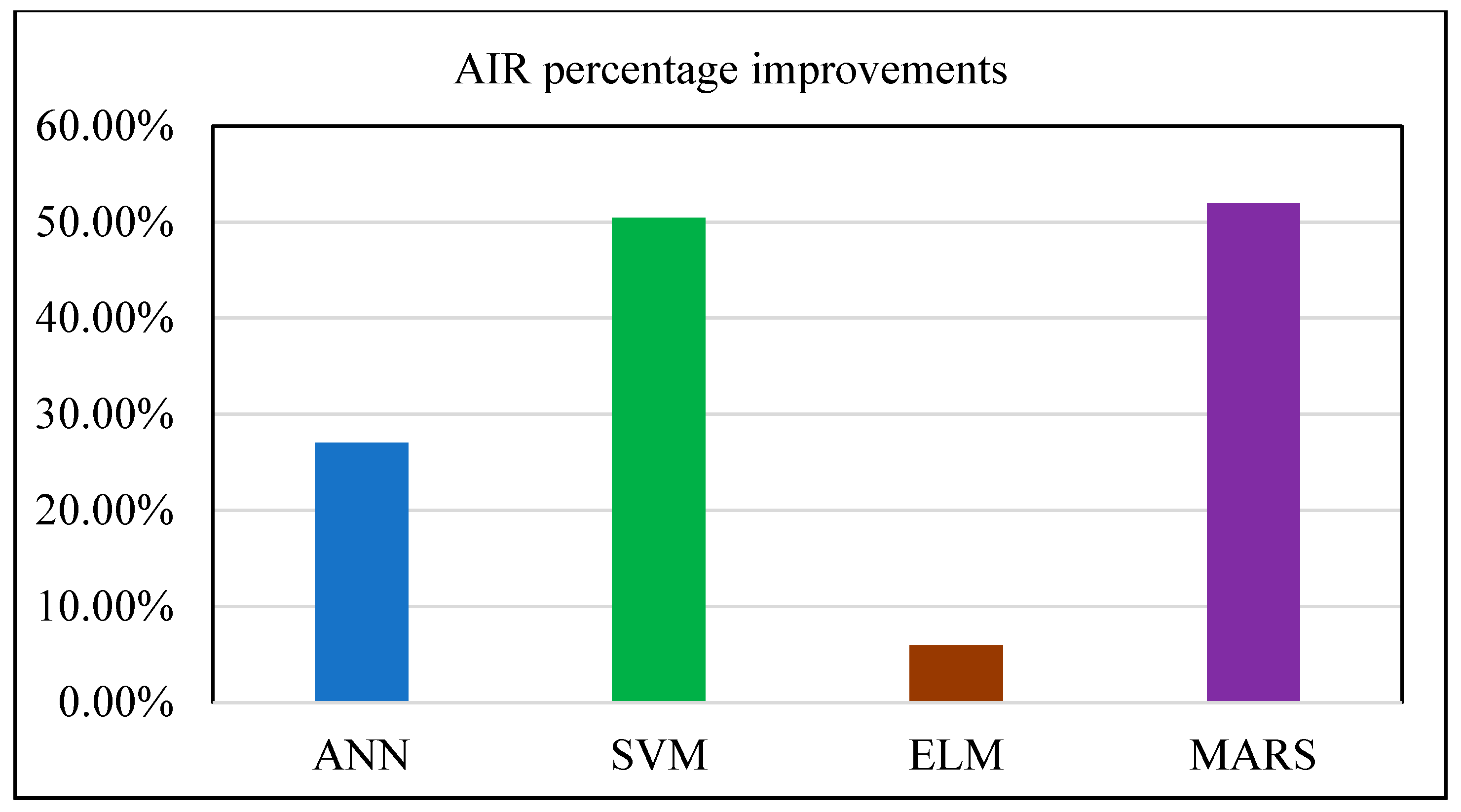
| 2 Single Disturbances | 3 Single Disturbances |
|---|---|
| (1) {SHI-CYC} | (1) {SHI-CYC-SYS} |
| (2) {SHI-SYS} | (2) {SHI-CYC-STR} |
| (3) {SHI-STR} | (3) {SHI-SYS-STR} |
| (4) {CYC-SYS} | (4) {CYC-SYS-STR} |
| (5) {CYC-STR} | |
| (6) {SYS-STR} |
| Types of MCCPs | AIR-ANN (Parameters: {ni, nh, no}) | AIR-SVM (Parameters: {C, γ}) | AIR-ELM (Parameters: {En, Eh, Eo}) | AIR-MARS (Parameters: {null}) |
|---|---|---|---|---|
| SHI-CYC | 68.50% | 68.67% | 68.60% | 68.50% |
| {1, 1, 1} | {2−5, 2−5} | {1, 6, 1} | ||
| SHI-SYS | 65.00% | 64.00% | 65.32% | 64.17% |
| {1, 4, 1} | {2−5, 2−5} | {1, 6, 1} | ||
| SHI-STR | 76.50% | 77.50% | 77.05% | 76.50% |
| {1, 3, 1} | {2−4, 2−5} | {1, 5, 1} | ||
| CYC-SYS | 51.50% | 57.33% | 56.38% | 58.50% |
| {1, 4, 1} | {2−2, 2−5} | {1, 29, 1} | ||
| CYC-STR | 64.33% | 64.17% | 61.00% | 64.83% |
| {1, 3, 1} | {2−1, 2−5} | {1, 6, 1} | ||
| SYS-STR | 73.67% | 73.00% | 71.81% | 73.00% |
| {1, 2, 1} | {20, 2−5} | {1, 18, 1} |
| Types of MCCPs | AIR-ANN (Parameters: {ni, nh, no}) | AIR-SVM (Parameters: {C, γ}) | AIR-ELM (Parameters: {En, Eh, Eo}) | AIR-MARS (Parameters: {null}) |
|---|---|---|---|---|
| SHI-CYC | 99.67% | 99.67% | 99.93% | 99.17% |
| {2, 3, 1} | {25, 20} | {2, 29, 1} | ||
| SHI-SYS | 100.00% | 100.00% | 99.98% | 100.00% |
| {2, 2, 1} | {23, 25} | {2, 30, 1} | ||
| SHI-STR | 98.67% | 99.83% | 99.76% | 99.83% |
| {2, 3, 1} | {25, 22} | {2, 30, 1} | ||
| CYC-SYS | 58.67% | 53.33% | 58.85% | 55.50% |
| {2, 6, 1} | {23, 2−4} | {2, 21, 1} | ||
| CYC-STR | 72.33% | 69.83% | 70.57% | 62.33% |
| {2, 3, 1} | {2−3, 2−5} | {2, 29, 1} | ||
| SYS-STR | 57.17% | 73.67% | 59.38% | 52.33% |
| {2, 2, 1} | {2−3, 2−3} | {2, 30, 1} |
| Types of MCCPs | AIR-ANN (Parameters: {ni, nh, no}) | AIR-SVM (Parameters: {C, γ}) | AIR-ELM (Parameters: {En, Eh, Eo}) | AIR-MARS (Parameters: {null}) |
|---|---|---|---|---|
| {SHI-CYC-SYS} | 47.11% | 42.33% | 32.23% | 33.33% |
| {1, 1, 1} | {25, 2−5} | {1, 10, 1} | ||
| {SHI-CYC-STR} | 53.89% | 30.67% | 48.18% | 42.33% |
| {1, 4, 1} | {25, 2−5} | {1, 13, 1} | ||
| {SHI-SYS-STR} | 54.78% | 43.00% | 56.88% | 38.22% |
| {1, 4, 1} | {25, 2−5} | {1, 7, 1} | ||
| {CYC-SYS-STR} | 45.89% | 64.00% | 60.45% | 33.11% |
| {1, 3, 1} | {25, 2−5} | {1, 14, 1} |
| Types of MCCPs | AIR-ANN (Parameters: {ni, nh, no}) | AIR-SVM (Parameters: {C, γ}) | AIR-ELM (Parameters: {En, Eh, Eo}) | AIR-MARS (Parameters: {null}) |
|---|---|---|---|---|
| {SHI-CYC-SYS} | 72.11% | 67.44% | 50.00% | 66.67% |
| {2, 3, 1} | {25, 22} | {2, 29, 1} | ||
| {SHI-CYC-STR} | 77.78% | 79.56% | 60.66% | 66.67% |
| {2, 3, 1} | {2−1, 25} | {2, 30, 1} | ||
| {SHI-SYS-STR} | 78.56% | 79.33% | 49.97% | 66.33% |
| {2, 3, 1} | {25, 23} | {2, 30, 1} | ||
| {CYC-SYS-STR} | 27.78% | 44.44% | 48.86% | 23.67% |
| {2, 6, 1} | {25, 2−3} | {2, 30, 1} |
© 2020 by the authors. Licensee MDPI, Basel, Switzerland. This article is an open access article distributed under the terms and conditions of the Creative Commons Attribution (CC BY) license (http://creativecommons.org/licenses/by/4.0/).
Share and Cite
Shao, Y.E.; Hu, Y.-T. Using Machine Learning Classifiers to Recognize the Mixture Control Chart Patterns for a Multiple-Input Multiple-Output Process. Mathematics 2020, 8, 102. https://doi.org/10.3390/math8010102
Shao YE, Hu Y-T. Using Machine Learning Classifiers to Recognize the Mixture Control Chart Patterns for a Multiple-Input Multiple-Output Process. Mathematics. 2020; 8(1):102. https://doi.org/10.3390/math8010102
Chicago/Turabian StyleShao, Yuehjen E., and Yu-Ting Hu. 2020. "Using Machine Learning Classifiers to Recognize the Mixture Control Chart Patterns for a Multiple-Input Multiple-Output Process" Mathematics 8, no. 1: 102. https://doi.org/10.3390/math8010102
APA StyleShao, Y. E., & Hu, Y.-T. (2020). Using Machine Learning Classifiers to Recognize the Mixture Control Chart Patterns for a Multiple-Input Multiple-Output Process. Mathematics, 8(1), 102. https://doi.org/10.3390/math8010102




